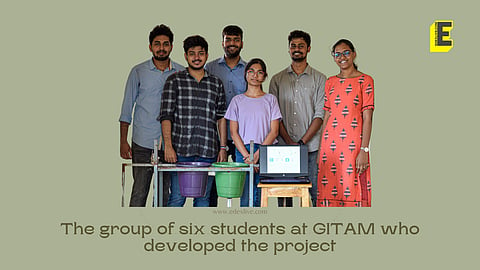

What if there was a way in which you could reuse the water discarded after using it in kitchen sinks? Believe it or not, that is exactly what a group of six students from the Gandhi Institute of Technology and Management (GITAM) at Visakhapatnam in Andhra Pradesh are working on and have even developed an alpha model of the project. In what could be a real game-changer in the way domestic households use and reuse water, we talked to the group of students to know more about the idea, its inspiration and how they are being mentored at their institute. The project titled Hydro Gravitricity project is being incubated at the Venture Development Centre of GITAM.
Anik Panja, one of the team leaders of the project, says that the initial idea was something completely different. "We were first trying to think along the lines of generating power from rainwater collected on rooftops. We felt that it could be something that people would buy into as it could help save money. But then the water crisis hit in Chennai and we became more aware of the water shortage at various places and, gradually, after many iterations, we stumbled on the idea of the smart water-recycling system," explains Anik.
Anik goes on to explain the practicality behind the project. He says, “An average household generates about 356 litres of grey water every day. We are talking about a huge amount if multiplied by thousands of homes in a city, never mind the industries and restaurants. This water is of no use as of today as it simply drains away. Recycling it in some capacity can address uses wherein the water does not need to be of drinkable quality. What we have come up with is a plug-and-play grey water recycling system that can be retrofitted into existing kitchen pipes. It is also smart, hassle-free and self-maintaining, reducing the effort required for maintenance. It comes with integrated sensors in the system, allowing it to adjust the self-maintenance cycle and generate a live report for the user to monitor the water usage and output quality.”
Bollem Raja Kumar, one of the team's mentors at GITAM, explains the working function of the project in detail. “The students have come up with a self-maintaining, smart and retrofittable rainwater and grey water filtration system. It consists of multiple stages fitted with filters, membranes and sedimentation tanks, with a grease trap. Sand and charcoal filters thoroughly clean the water. Built-in sensors provide real-time data on water quality and parameters such as pH, turbidity, TDS and water volume. The filtered water can be used for irrigation, cleaning, and flushing toilets. The students integrated the various knowledge systems and engineered them to fit into a limited space.”
The students are now looking at applying their product at water-intensive manufacturing plants like steel industries to install and test its feasibility. Prithvi Tripathy, a member of the project's group, added, “We have been allocated funds and space by GITAM to build and test our prototype, giving us the ability to fine-tune the product faster. We are now working towards getting access to various water-testing labs in the country to validate the results published by our research."
Vikas Kumar Srivastav, another of the team's coaches, emphasised the importance of pursuing a project as vast as this parallel to academics. He praised the students for their commitment and drive. "One would also have to give credit to the parents of the students because today it is difficult to convince the elders to have their children involved in anything apart from their curriculum and placements at college," he points out.
Anik also mentions the crucial interventions they have received at various junctures, allowing them to streamline the final output. "One of the earliest pivots we received was from a professor at Northeastern University who guided us to think towards applying the Gravitricity to industries as they have much larger water output after use. That turned out to be a huge tip for us in the right direction," he narrates. Anik says the real challenge now would be to scale up their project so that it becomes cost-effective and practical.
Sai Sasikanth Rokkam, a third member of the team, offers a take on the upcoming targets the students have set for themselves. "We will work on developing the solution further with mentoring by Atal Innovation Mission incubators and the Denmark Technical University. We intend to apply for relevant grants from NITI Aayog to design a medium-scale prototype and bring the product to the market,” he says.
All the three students above, along with Jeswin GN and Shivani Narsina, belong to the Electronics and Communication Engineering department at GITAM, while the sixth member Rushali Mishra is a second-year BSc Environmental Science student.
